Prophylaxis
- Keep the flower warm, but not near the battery.
- Do not let the sun "touch" the leaves; on hot summer days, shade the window with a curtain.
- Water the pot only when the top of the soil is dry. In the summer, take out the watering can almost every day, in the winter - much less often. And don't forget that the water should be soft. If it is from the tap, at least let it settle for a day (and ideally, filter the water, for flowers you can even take water from a reverse osmosis filter). Also remember that the water should not be cold - only room temperature or lukewarm.
- Top dressing on time. Before making them, you need to water the soil with plain water, so you will protect the flower from scalding the root system.
- Do not forget about frequent spraying (you can take both pure water and a solution of succinic acid), wiping the leaves from dust.
- When transplanting, buy a pot slightly wider than the old one. If the roots are cramped for a long time, this can also affect the shade of the leaves.
In general, the best prevention of yellowing (and any other painful conditions of a flower) is proper care.
This video will also teach you how to "make friends" with female happiness correctly:
Natural habitat and growing conditions
To understand how to save spathiphyllum from chlorosis and blackening of foliage, you need to turn to the facts:
- where the flower grows;
- what are the conditions;
- how the natural habitat differs from those offered to the plant at home.
The tropics are humid forests, but well lit. The temperature there is about the same throughout the year - it is always above 18 degrees. There are slight variations depending on the season. In the winter months it can be colder: up to 10 - 15 degrees.
Spathiphyllum grows in tropical monsoon climates. It is characterized by a uniform distribution of precipitation and slight fluctuations in air temperature - only 4 degrees.
If you imagine the conditions of the middle zone, then they will be very different - hot summers and too cold winters. To smooth out such differences, people turn on their heating devices in winter and air conditioners in summer. Any significant fluctuations are destructive for flowers, so their immunity may not cope with diseases.
Video: Why do spathiphyllum leaves turn yellow
What to do?
The advice of professionals will help save spathiphyllum from drying out and death. First, identify the problem, then you can easily find ways to solve it.
- If your flower grows dark and dry at the ends, most likely it is not properly cared for. Check if your pet is getting enough moisture, not too rarely you water it. Excess water is also possible. If the leaves of the spathiphyllum turn black everywhere, then a transplant is necessary.
- Another reason for leaf darkening is improperly selected soil or drafts. Transplant the plant properly into suitable soil. Remove the flower from the window to protect it from cold air currents. Since “female happiness” is shade-loving, it grows beautifully in the back of the room, sitting on a special stand.
- A serious problem arises when the leaves turn black from the middle. "Women's happiness" loves warmth, moisture and sufficient watering, and these are ideal conditions for the growth of the fungus. It causes rotting of the roots, drying of the leaf, the flower stops flowering. If you suspect a fungal infection, immediately tear off the diseased leaves, then spray the entire plant with a fungicide.
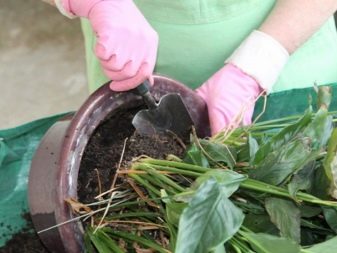

It is possible to use folk methods to combat the fungus. To do this, you need to make an infusion of citrus peels according to the following recipe:
- take 150 g of orange or lemon peels, fill with water;
- let it brew for 2 hours, then strain;
- spray the plant with the resulting infusion 2-3 times a day for a week.
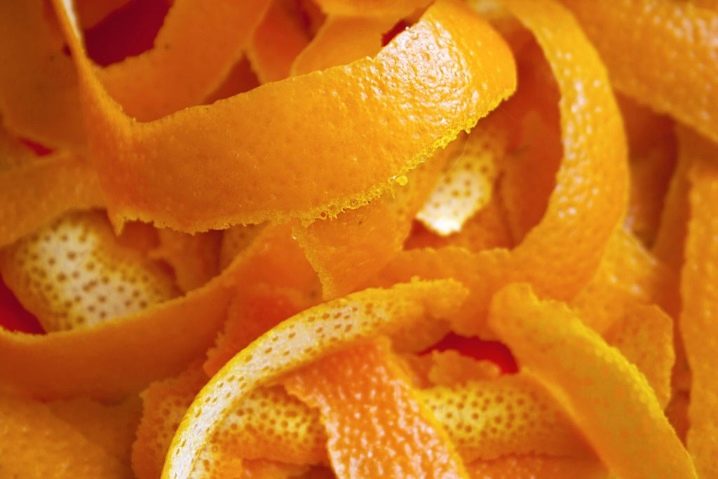
Temperature
They belong to heat-loving plants, therefore they react painfully to cold and sudden changes in temperature. First of all, the elasticity of their leaves disappears, after which they become wrinkled, lethargic, turn yellow and gradually dry out. Therefore, it is not recommended to keep them near an open window in cool weather, as well as near heating appliances.
The ideal temperature for keeping them is + 23 ° C. At temperatures below + 17 ° C or above + 30 ° C, he can get sick. Nevertheless, the room containing spathiphyllum must be regularly ventilated, but the container with it must be away from drafts.
How does the yellowing of spathiphyllum leaves appear?
Spathiphyllum (Spathiphyllum) is a popular houseplant that has beautiful green leaves and white inflorescences. The flower is often called “female happiness”. There is also a similar plant, the anthurium, known as the "male flower". It can also be grown at home.
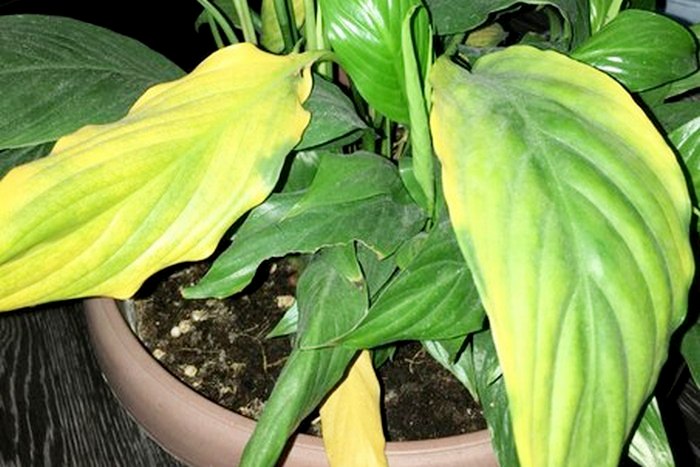
Yellowing of the leaves is the result of improper care
The yellowing of the leaves is an abnormal process, during which they completely or partially change color, becoming yellow, and lose their turgor.
Important! Old leaves can turn yellow and fall off - this is considered a natural process of culture rejuvenation. In this case, it is not recommended to worry.
If the violation of the shade of the leaves becomes massive, you need to pay attention to the condition of the plant and identify the causes of the problems. This will help you find the right ways to treat the flower.
In most cases, there are such types of yellowing of the culture:
Peduncles and leaves become yellow and wither. Such symptoms indicate improper care of the plant.
Leaves turn yellow and lose their integrity
In this case, you should pay attention to the back of the leaves. They probably contain insects.
Leaves changed color and wilted
This situation is observed with excessive watering.
The leaf plates are covered with white cobwebs. This symptom indicates attacks by spider mites.
The leaves become flabby and wither. Most often, this symptom is caused by too low room temperature.
Other symptoms that accompany the appearance of a yellow tint on the leaves include brown spots, rotting stems, mold on the surface of the earth. Sometimes the leaf plates can turn black.
How to care for the plant when flooding?
Watering the spathiphyllum too generously can lead to flooding. In this case, you need to get the flower out of the pot and rinse the roots with water. When carrying out the procedure, you need to completely get rid of the soil. Now examine the roots for signs of rot. The diseased areas acquire a brown tint and become soft (we talked about how to treat spathiphyllum for leaf diseases and how the affected areas of the plant look in the photo here). Treatment consists of removing rotten roots with a sterile knife.
To prevent the penetration of pathogenic microorganisms, crushed activated carbon should be applied to a fresh cut. Alternatively, you can use "Glyocladin". The product has bactericidal properties and is intended for the treatment of damaged areas.
After drying, transplant the flower into new soil, to which it is recommended to add activated charcoal. After removing the rotten areas, spathiphyllum should not be watered for 2-3 days. To stimulate the growth of roots, it is necessary to add the drug "Kornevin" to the water.
When is it natural?
Despite the large number of reasons why a plant can turn yellow, there are also natural ones. An old plant (over 5 years old) can thus get rid of unnecessary foliage. Thus, he produces self-rejuvenation and prepares for the appearance of new leaves. You can wait until they fall off by themselves, or you can cut them off at the base with sharp scissors for aesthetic reasons.
During the dormant period (autumn - winter), the leaves of the spathiphyllum may lighten a little and become soft, but do not be afraid. With the onset of spring, they will again become rich in color and gain elasticity. Thus, the flower accumulates resources for further flowering.
Features of spathiphyllum care
The plant is not demanding on lighting and feels great in partial shade and in diffused light. If the pot with a bush is in the shade, the foliage will acquire a rich green hue, and the shape of the leaf plate will become elongated. However, this may stop the flowering of spathiphyllum.
Placing the plant on a south window can result in leaf burns. Thus, you can put the plant on the north window, but you are unlikely to get flowers. When choosing a south window, take care of protecting the crown from sunlight. In this case, your spathiphyllum will be healthy, strong and blooming profusely.
As for the temperature regime, in spring and summer it is necessary to adhere to 22-23 degrees, and in autumn and winter, make sure that the thermometer does not drop below 16 degrees.
Note: spathiphyllum reacts extremely negatively to drafts in the room.
Spathiphyllum needs high air humidity. To create optimal conditions, the following techniques are used:
- spraying with soft water;
- placing a container with a plant in a pallet with wet moss or sand;
- growing spathiphyllum in an aquarium;
- organization of a warm shower once a month.
Tip: during spraying, water should not get on the inflorescences.
Spathiphyllum should be transplanted very carefully, since the root system of the plant is rather weak and after the procedure, the bush can adapt to new conditions for a long time. Transplanting the plant is necessary when the roots occupy the entire volume of the flower pot.
There are several methods for reproduction of spathiphyllum:
- cuttings;
- division of the root system.
Drying out the tips of the leaves
Drying of the tips of the leaves in an insufficiently humid environment in spathiphyllum, "standard" for any moisture-loving plant, appears as a dry, dark speck at the point itself. Most often, it almost does not affect the main leaf blade, not so much affecting the decorative effect.
So spathiphyllum reacts to extremely dry air (in general, the plant tolerates the usual average conditions of living rooms much better than competitors), but not only. The tips of the leaves of spathiphyllum can also dry out with unstable, constantly changing humidity in the air or soil.
It is difficult to avoid drying out the tips of the leaves without measures for installing any kind of humidifier and creating a stable humidity, it can manifest itself even with frequent spraying.
It is easy to prevent the phenomenon: in rooms with dry air and operating air conditioners or heating systems, it is enough to place bowls and pallets with damp materials nearby. You can group plants with moisture-loving counterparts around humidifiers and shower more frequently.
Other measures are also important:
- hygiene, prevention of dust accumulation on the leaves of spathiphyllum;
- protection of spathiphyllum from direct proximity to heating devices.
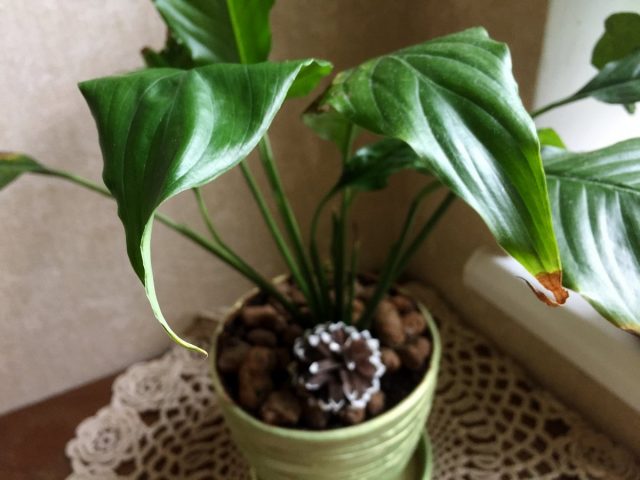 By drying the tips of the leaves, spathiphyllum reacts to extremely dry air. Botanichka
By drying the tips of the leaves, spathiphyllum reacts to extremely dry air. Botanichka
Other reasons
Drying of the flower may be associated with a lack of trace elements. It is recommended to transplant the plant to new soil, which should be slightly acidic. Treat the plant with an iron chelate.To compensate for the lack of minerals, you can use complex fertilizers:
- Kemira Lux;
- Uniflor;
- Garden of Miracles.
Do not exceed the dosage indicated in the instructions, as an excess of nitrogen fertilizers can cause yellowing of the leaves. In the summer, the plant needs to be fed once a week. In winter, fertilizer must be applied once a month.
Due to too dry indoor air, black spots may appear on the leaves of the flower. You can use a moisturizer to help the plant. Most often, this problem occurs in winter. At the same time, the air emanating from the hot battery dries the flower.
To eliminate the cause of the drying out of the plant, you can use several methods:
- You can solve the problem by placing moss in a pot.
- It is recommended to place a container next to the plant into which you need to pour water.
After transplanting spathiphyllum, flower growers face difficulties:
- mistakes can be associated with the wrong choice of a pot;
- the hot sun has an adverse effect on the plant;
- the flower should not be constantly in the shade.
To provide favorable conditions for plant growth, the root system must fit snugly against the bottom of the pot.
Description of the problem and symptoms
Usually the problem does not develop at lightning speed, but gradually, becoming more noticeable from day to day. At first, the plant begins to lose its decorative effect, acquiring a painful appearance. In these cases, the leaves of the spathiphyllum droop, losing their original turgor, juiciness and glossy shine. Against the background of changes in the tissues of the leaf plate, the natural process of photosynthesis is disrupted. As a result, the foliage of the plant begins to fade, turn yellow and wrinkle. Due to disturbed biological processes, the leaf plate loses its elasticity, becomes brittle, begins to crumble and, as a result, simply disappears.
Leaves may dry out unevenly. Most often, the problem begins with the fact that the edges of the leaves dry out in spathiphyllum, the ends darken and dry out. If the cause is not established in a timely manner and the necessary measures are not taken, the foliage of the plant will dry out rather quickly and fly around.
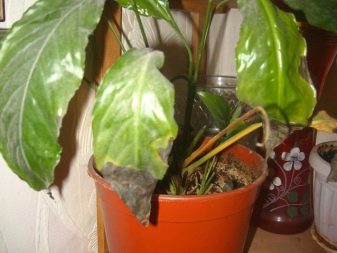
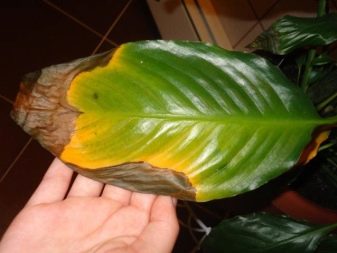
Over time, the old and exhausted leaves are replaced by new ones. This is an integral process that accompanies the development of any plant. In addition, drying and yellowing of foliage in spathiphyllum may be due to the previous long flowering, which depleted the strength of the plant.
There are often cases when spathiphyllums temporarily lose their decorative effect, begin to turn yellow and dry out shortly before the flowering period. Plant breeders explain this phenomenon by the fact that in this way the representatives of the tropical flora accumulate the strength they need to form buds. In this case, slight yellowing and drying of the leaves is not a critical deviation from the norm.
The concern should be the massive wilting and drying of leaves, both old and young. In some cases, this pathological process may be accompanied by the formation of strange spots of yellowish, gray-white, brown-brown or black color on the leaves. This directly indicates serious disturbances and changes in the general condition of the plant.
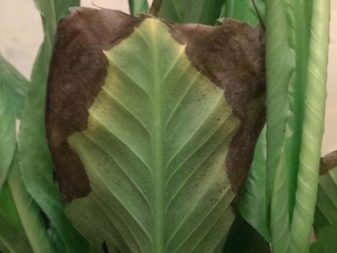
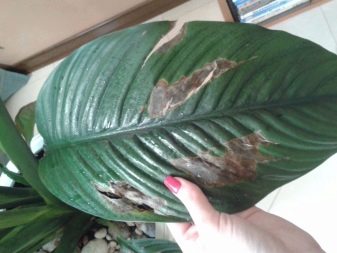
How to save a flower?
Remedial action should be carried out based on the cause of the problem.
If the flower begins to turn yellow, wither or dry, it is necessary to create the most gentle conditions for it. For this, the plant is placed in a place with soft diffused light, a constant temperature of 22-23 °, a stable air humidity within 65%. To maintain a stable indoor humidity, plants should be sprayed with a spray bottle. This must be done daily.
There should be no drafts in the room where the injured spathiphyllum is located. For the duration of the airing of the room, the plants should be moved to another place.
Completely dried leaves must be removed with sharp scissors. This will stimulate the growth of new young foliage.
If the reason for the drying of the plant is inappropriate humidity or irregularities in the irrigation regime, it is advisable to install a wide pan with water next to the pot. And also a household humidifier can provide significant assistance in restoring exotic plants at home.
Experienced growers recommend washing the intact leaves with soap and water during the recovery period.
This procedure is carried out once a week.
If the affected plant is provided with all the necessary conditions, but it is still in no hurry to recover, it is allowed to carefully remove it from the pot to inspect the roots and substrate. This measure will allow to confirm or exclude the presence of diseases of the root system or its damage by pests.
If the plant has suffered from root rot, complex treatment with the use of fungicidal preparations is required. If pests are found on the roots or in the substrate, it is necessary to carry out a thorough treatment with insecticides. In both cases, it is required to completely replace the infected substrate, disinfect the pot and plant roots.
7 Why do flowers turn green in a flower
During flowering, spathiphyllum releases graceful inflorescences in the form of a small cob surrounded by a white blanket, shaped like an ordinary leaf, devoid of a petiole. Often, the whiteness of the inflorescence does not last long, the flower acquires a greenish tint, indicating the end of the flowering period. This is a natural process for this plant and should not be a cause for concern.

In a white-flowered plant, the flowers turn green, and the foliage begins to fade if direct sunlight falls on the spathiphyllum. In this case, the pot with a bush is transferred to a place with diffused light. And in winter, the flower requires an additional source of light.
Green inflorescences can signal a shortage or oversaturation of fertilizers. In this case, it is necessary to adjust the plant feeding schedule.
When and what should be treated, how to do it?
Urgent resuscitation is done when previous efforts have not yielded a positive effect and the pet's condition worsens every day.
Black leaves, delayed flowering, dark root system, withered crown of young shoots, growth retardation are clear signs of a dying bush. How to cure a plant?
Rescue takes place as follows:
- The spathiphyllum is removed from the pot and the rotten roots are trimmed.
- Intact roots are washed with potassium permanganate. After that, they are treated with activated carbon and wrapped in newspaper for a day.
- While they dry out, a container with new soil is prepared. The soil is poured into the pot after the drainage holes have been made and the drainage layer has been laid.
- Further, the flower is transplanted into a new land.
- Watering is not performed immediately after transplanting. From above, the spathiphyllum is covered with plastic wrap or a plastic bottle, creating the effect of a greenhouse.


